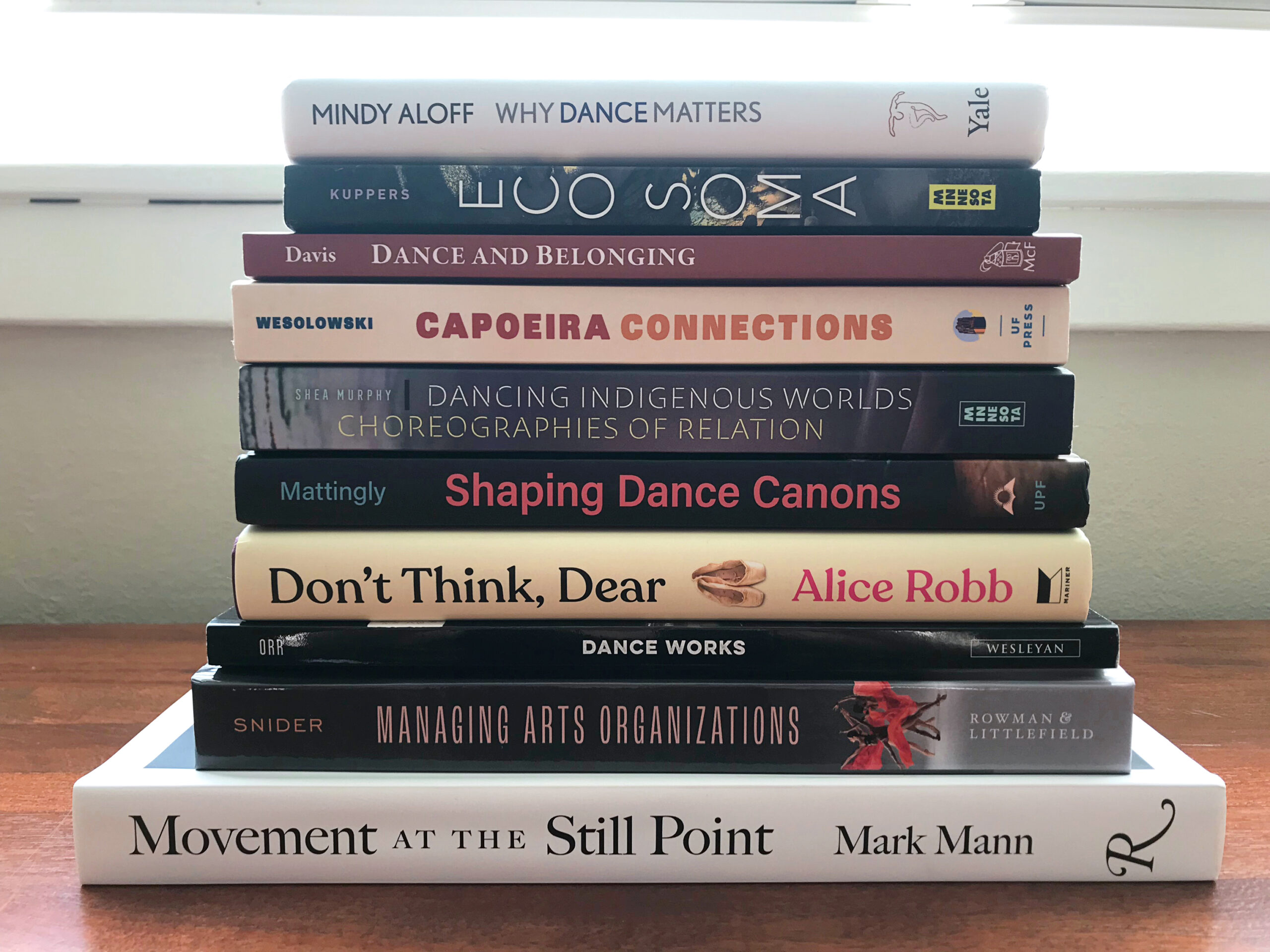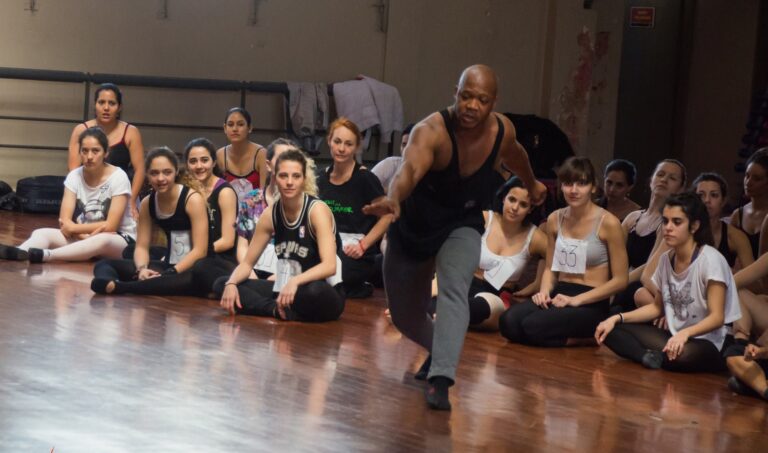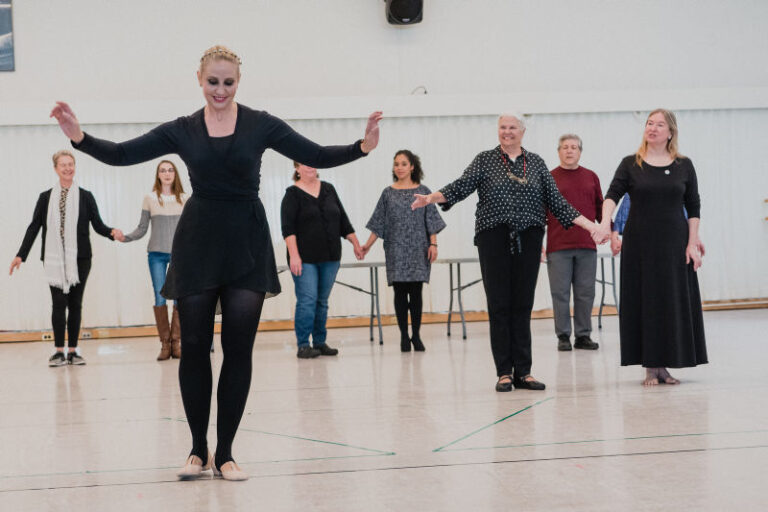
Like a long-awaited performance premiere, many books on dance and dance education are developed and crafted over several years. The 10 new titles shared here clearly show the writers’ devotion to the form and to the field at large. It is a wonderful, varied collection ranging from memoirs to philosophical musings, from the basics of arts administration to a deep questioning of bias in dance education.
Whether you are starting to build your summer reading list, want to share new titles with your graduate students to support their research, or are just looking for some inspiration this spring, check out previews of these new books below.
Open Access Titles: Read These Books for Free Online
Through some exciting open access projects in higher education, both of the following books can be enjoyed online, in their entirety, free of charge.
In Eco Soma: Pain and Joy in Speculative Performance, Petra Kuppers, a professor at the University of Michigan and a 2023 Guggenheim Fellow, invites us to explore somatics in a new way (“eco soma”) that bridges ourselves and our environments. This book takes us through explorations of performance and artistic engagement, considering dance, disability, and somatics. Read Eco Soma online here.
It has been quite a few years since a new title on capoeira came into print in English. Duke University professor Katya Wesolowski’s memoir Capoeira Connections shares her several-decades-long journey around the world from student to instructor while also looking at the form through the themes of connection and community-building. Capoeira Connections is available to download free here.
Questioning Bias and Power in the Classroom and on the Page
The much publicized Don’t Think, Dear: On Loving and Leaving Ballet, by Alice Robb, is a blend of personal narrative and ongoing research. Robb uses her own experiences at the School of American Ballet as the starting-off point for her exploration into the lure of ballet and ballerina’s mindsets. She covers a wide range of topics from Balanchine and Misty Copeland to sexual misconduct, body image, and racist stereotypes within dance. Don’t Think, Dear is also available in audiobook form, with Robb narrating. Hearing her share her story and journalistic take on ballet in her own voice only deepens its power.
Crystal U. Davis’ Dancing and Belonging: Implicit Bias and Inclusion in Dance Education is a key new book for the field to deeply consider bias in what—and how—we teach. Davis challenges us to unpack both our conscious and unconscious values about dance forms, ideal dancer bodies, and language describing dance.
Kate Mattingly’s Shaping Dance Canons: Criticism, Aesthetics, and Equity, pairs powerfully with Davis’ work. Mattingly excavates 100 years of dance criticism to question whose voices are foregrounded in the press, exploring how this elevated some companies and left others in the shadows, and how biases and exclusions play out in dance writing.
Why Dance Matters: Three New Viewpoints
Longtime dance writer Mindy Aloff’s new book of essays, Why Dance Matters, weaves together stories of dance performances with Aloff’s connections to broader life themes, like childhood and walking. A great springtime read about why we dance and watch dance, the collection is a part of a series produced by Yale University Press entitled “Why X Matters.” The central question of Aloff’s book is also the theme of the two other titles below.
In Allison Orr’s Dance Works: Stories of Creative Collaboration, Orr lovingly shares her 20 years in the field and the extensive and layered community-based projects she takes on. Based in Austin, Texas, with her company, Forklift Danceworks, Orr’s artistic endeavors involve ambitious visions, like getting firefighters and sanitation workers to create and perform dances. For anyone curious about doing community-based work and learning about the care, intention, and time that art making entails, this is a must-read.
Jacqueline Shea Murphy’s Dancing Indigenous Worlds: Choreographies of Relation explores interconnection and exchange. Murphy details contemporary Indigenous dance practices within modern dance with artists in North America and Aotearoa (the Maori word for New Zealand). Based on decades of conversations with Indigenous artists, Dancing Indigenous Worlds also tackles the ethical question of covering Indigenous art as a non-Indigenous scholar.
Supporting Arts Management
Managing Arts Organizations, by David Andrew Snider, is a bit more on the practical side. Books on arts administration are quite a rarity, and it is exciting to see Snider’s new versatile offering, which could be used as a college textbook or as a useful read for new and seasoned arts administrators alike. The book’s clear format provides practical examples from the field, covering topics from budgets to boards to staff evaluations.
Capturing the Dancing Moment
Lastly, Mark Mann’s Movement at the Still Point is a book of photographs born from the pandemic. Mann photographed over 100 dancers, capturing both portraits and action shots in stunning black-and-white. The wide range of dancers come from contemporary dance, Broadway, ballet, hip hop, and more: Catch a glimpse of famous dancers like Chita Rivera, Misty Copeland, and Kyle Abraham, as well as over dozens of others. This is a beautiful gift to give a fellow dance-lover in your life, or a worthwhile investment for your studio’s lobby to delight students and their families this semester.





